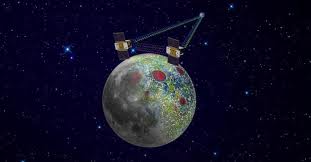 After just over three months in orbit around the moon, NASA’s twin Gravity Recovery and Interior Laboratory (GRAIL) spacecraft have officially entered into the data collection phase of their space mission. Launched late last year, the two spacecraft entered orbit around the moon on New Year’s Eve and New Year’s Day.
After just over three months in orbit around the moon, NASA’s twin Gravity Recovery and Interior Laboratory (GRAIL) spacecraft have officially entered into the data collection phase of their space mission. Launched late last year, the two spacecraft entered orbit around the moon on New Year’s Eve and New Year’s Day.
For the next three months the GRAIL spacecraft will deliver to researchers on Earth an unprecedented high-resolution map of the lunar gravitational field which will allow them to better understand the internal structure of the moon including its composition like never before. According to NASA, the insight which the GRAIL mission will provide will also lead to a better understanding of how the Earth and other rocky planets in the solar system formed and evolved.
“The initiation of science data collection is a time when the team lets out a collective sigh of relief because we are finally doing what we came to do,” said Maria Zuber, principal investigator for the GRAIL mission at the Massachusetts Institute of Technology in Cambridge. “But it is also a time where we have to put the coffee pot on, roll up our sleeves and get to work.”
While the twins were originally designated GRAIL A and GRAIL B, after a nationwide contest which queried students to come up with better names for the spacecraft, the two are now referred to as Ebb and Flow respectively. The renaming contest was another effort on the part of NASA to engage students in space exploration and science. With submissions from close to 900 classrooms and over 11,000 students in 45 states, the chosen names were submitted by fourth graders from the Emily Dickinson Elementary School in Bozeman, Montana.
To create the detailed mapping of the lunar gravitational field, Ebb and Flow transmit radio signals which precisely define the distance between them. Slight variations in this distance will be noted as they fly over areas of greater and lesser gravity. The changes are the result of features such as mountains, craters and masses hidden beneath the lunar surface.
“We are in a near-polar, near-circular orbit with an average altitude of about 34 miles (55 kilometers) right now,” said David Lehman, GRAIL project manager from NASA’s Jet Propulsion Laboratory (JPL) in Pasadena, Calif. “During the science phase, our spacecraft will orbit the moon as high as 31 miles (51 kilometers) and as low as 10 miles (16 kilometers). They will get as close to each other as 40 miles (65 kilometers) and as far apart as 140 miles (225 kilometers).”
Ebb and Flow will map the moon’s gravity field 3 times before concluding this primary mission objective on or about May 29th.
![Herbal Reference Substances are Key to Everyday Products <!-- AddThis Sharing Buttons above -->
<div class="addthis_toolbox addthis_default_style " addthis:url='http://newstaar.com/herbal-reference-substances-are-key-to-everyday-products/3512112/' >
<a class="addthis_button_facebook_like" fb:like:layout="button_count"></a>
<a class="addthis_button_tweet"></a>
<a class="addthis_button_pinterest_pinit"></a>
<a class="addthis_counter addthis_pill_style"></a>
</div>When it comes to quality control testing and the development of new products, Botanical Reference Materials (BRMs), also known as Herbal References are critically important. To help companies ultimately obtain all-important FDA approval, the Food and Drug Administration provides in its guidance a recommendation that […]<!-- AddThis Sharing Buttons below -->
<div class="addthis_toolbox addthis_default_style addthis_32x32_style" addthis:url='http://newstaar.com/herbal-reference-substances-are-key-to-everyday-products/3512112/' >
<a class="addthis_button_preferred_1"></a>
<a class="addthis_button_preferred_2"></a>
<a class="addthis_button_preferred_3"></a>
<a class="addthis_button_preferred_4"></a>
<a class="addthis_button_compact"></a>
<a class="addthis_counter addthis_bubble_style"></a>
</div>](http://newstaar.com/wp-content/uploads/2021/02/Achillea_millefolium_flowers-100x100.jpg)
![Quality Electrochemical Biosensors are Critical for Medical, Food and Chemical Industry <!-- AddThis Sharing Buttons above -->
<div class="addthis_toolbox addthis_default_style " addthis:url='http://newstaar.com/quality-electrochemical-biosensors-are-critical-for-medical-food-and-chemical-industry/3512086/' >
<a class="addthis_button_facebook_like" fb:like:layout="button_count"></a>
<a class="addthis_button_tweet"></a>
<a class="addthis_button_pinterest_pinit"></a>
<a class="addthis_counter addthis_pill_style"></a>
</div>A number of industries have, at their core, a need to frequent or even continuous analysis of biological media. These include the medical and pharmaceutical fields, biotech firms, and food and chemical companies. To maintain quality standards and develop new products, these industries rely heavily […]<!-- AddThis Sharing Buttons below -->
<div class="addthis_toolbox addthis_default_style addthis_32x32_style" addthis:url='http://newstaar.com/quality-electrochemical-biosensors-are-critical-for-medical-food-and-chemical-industry/3512086/' >
<a class="addthis_button_preferred_1"></a>
<a class="addthis_button_preferred_2"></a>
<a class="addthis_button_preferred_3"></a>
<a class="addthis_button_preferred_4"></a>
<a class="addthis_button_compact"></a>
<a class="addthis_counter addthis_bubble_style"></a>
</div>](http://newstaar.com/wp-content/uploads/2020/10/Electrochemical-Biosensor-100x100.jpg)
![Company Develops Industrial Mixers Well-Suited for both Fragile and Explosive Products <!-- AddThis Sharing Buttons above -->
<div class="addthis_toolbox addthis_default_style " addthis:url='http://newstaar.com/company-develops-industrial-mixers-well-suited-for-both-fragile-and-explosive-products/3512071/' >
<a class="addthis_button_facebook_like" fb:like:layout="button_count"></a>
<a class="addthis_button_tweet"></a>
<a class="addthis_button_pinterest_pinit"></a>
<a class="addthis_counter addthis_pill_style"></a>
</div>Industrial drum mixers are normally applied to blend mixes of varying viscosities such as adhesive slurries or cement. Some of these mixers have the capability of blending mixes of very different particle sizes such as fruit and ice cream, and gravel and cement slurry. The […]<!-- AddThis Sharing Buttons below -->
<div class="addthis_toolbox addthis_default_style addthis_32x32_style" addthis:url='http://newstaar.com/company-develops-industrial-mixers-well-suited-for-both-fragile-and-explosive-products/3512071/' >
<a class="addthis_button_preferred_1"></a>
<a class="addthis_button_preferred_2"></a>
<a class="addthis_button_preferred_3"></a>
<a class="addthis_button_preferred_4"></a>
<a class="addthis_button_compact"></a>
<a class="addthis_counter addthis_bubble_style"></a>
</div>](http://newstaar.com/wp-content/uploads/2020/06/bandeau-sofragir2-100x100.jpg)